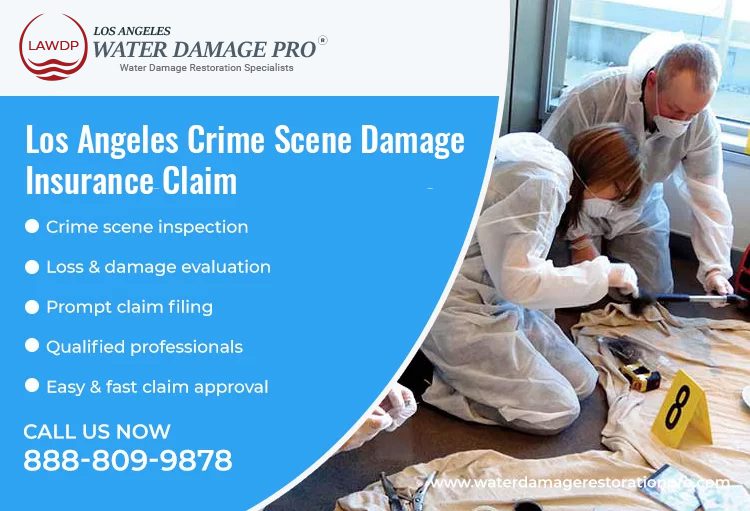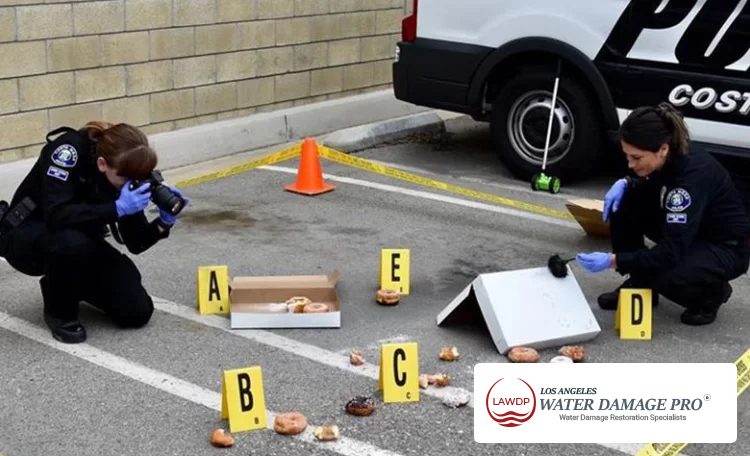- 24/7 Water Damage Emergency
- Licensed and Insured
- FREE Estimates
- Direct Insurance Billing
- Insurance Claims
Dealing with theft, vandalism, or a break-in? You’re not alone. According to FBI statistics, a robbery or theft occurs every 14.6 seconds. Los Angeles crime scene damage insurance claim can leave you feeling lost, stressed and unsure about how to proceed with your insurance company.

Walking into your home and finding out you’ve been robbed will make most people feel violated. It may come as a surprise that many robberies take place during the day, according to the FBI’s 2019 Uniform Crime Report.
About half of all robberies take place during the day and about 34% at night. The other 16% are unknown. And thieves usually get by with a decent score.
Burglary, as defined by the FBI, is an illegal entry into a structure with the intent to commit a felony or robbery. And while the 2019 FBI Uniform Crime Report shows a 9.5% decrease in robberies compared to 2018 and a 48.5% decrease compared to 2010, that doesn’t make the crime any less terrifying to those affected.
The FBI figures show that there are more than a million burglaries each year, resulting in property losses estimated at $3 billion. Data shows that historically around 55.7% of burglaries involve forced entry, 37.8% are illegal entries and 6.5% are attempted forced entry.
The thought of someone invading your privacy or safe space and going through your personal belongings can be traumatic. Aside from feeling violated, victims frequently also express feelings of powerlessness or loss of control, remorse, anger, dread, and anxiety.
After a break-in, you may not only find yourself emotionally traumatized by the event, but also have to deal with things like making repairs, changing locks, identifying lost items, and filing a home insurance claim.
We’ll go over some important considerations you need to know about crime related property insurance claims.
So, you have arrived at your home and you suspect that your home has been broken into. Above all, do not enter your house. If you have entered, please exit immediately. Avoiding the house is especially important because you don’t know if the thieves are gone. Call the police from your cell phone or a neighbor’s home line right away.
Until they arrive, try to avoid touching anything because the thieves might have left their prints. You should prepare a list of everything that has been taken, along with a description of each item and its purchase price, before the police show up. Finally, duplicate this list and give it to your insurance provider.
In the event of a theft, knowing what to expect and having a plan in place is essential. First of all, it is important to know and document what you own. Save your receipts and record your purchases. This will make it easier to prove the value and ownership of your possessions. Take an inventory of your personal property, group items by category, value, location in your home, etc.
List all items covered by your personal property insurance, including jewellery, art, collectables, computers, televisions, gaming systems, etc. Take photos of your items for your inventory to document the value and quality of each item. Once you’ve created an inventory, store the documents in a safe place, such as a secure online repository or a fireproof box.
Filing a crime scene damage insurance claim is never easy, but it can become even more difficult if your car is involved in the incident. A stolen car is not covered by your home insurance even if it was taken from your property. Theft or vandalism of your car would fall under the umbrella of your car insurance policy.
Insurance companies do not always require inspections. Before paying you, they might wish to look into or examine your claim. An investigation will help the insurance company verify your claim and identify any additional documentation that may be helpful, such as a copy of your police report. At an inspection, a field adjuster will come to your home to assess any physical damage.
When your claim is settled, you can expect to be reimbursed for the lost or damaged property as covered in your policy, less your deductible and any applicable depreciation. Your insurance company will provide you with documentation on all aspects of your claim outcome, so be sure to keep a copy of this documentation for your records.
Homeowners insurance generally includes coverage for theft and damage to your home due to a break-in. This does not necessarily mean, however, that you will be fully compensated for all stolen items.

Your homeowners’ insurance policy will cover you for “replacement cost” or “actual cash value.”
Replacement cost
You are reimbursed for the cost of replacing an item based on how much it currently costs.
For example, if you purchased an item 10 years ago for $100 but it is now $500, you will be refunded $500.
Actual cash value
You are reimbursed based on how much your item would sell for today, not the cost of a new item.
Using our example above, if you bought an item 10 years ago for $100 but it is only worth $50 today, you will only be refunded $50.
Theft is a problem covered by homeowners insurance. Home insurance will cover stolen personal property and will also pay for problems related to theft, such as the cost of repairing or replacing items that were damaged in a break-in.
For example, if a forced entry damages the door, your homeowners’ insurance may pay for repairs and new locks.
Here are some types of home insurance coverage that may apply if you are the victim of a home invasion and robbery:
Housing coverage
This pays for repairs to your home if it is damaged in a break-in. For instance, it might cover the cost of replacing doors and shattered windows.
Personal property coverage
This pays to repair or replace your personal belongings if they are damaged or stolen. For example, if a thief knocks over an expensive lamp or steals your laptop.
Coverage of other structures
This pays for repairs to separate structures on your property. For example, if your shed door is damaged in a break-in.
Your policy limits and the kind of coverage you have will determine how much coverage you have. Coverage for your home and other structures is pretty straightforward. For example, if you have a $250,000 limit on your homeowner’s coverage and your door was damaged in a burglary, repairs to your door would fall under your homeowners’ coverage, less your deductible.
Generally, the coverage limit for personal property is set at 50% to 70% of the homeowner’s coverage amount. For example, if you have homeowners coverage of $250,000 and purchased a policy that provides 70% personal property coverage, your belongings would be covered up to $175,000.
Standard items such as televisions, furniture, and appliances commonly found in most homes will likely be covered in full in the event of theft
But this is where personal property coverage gets a bit tricky. Certain types of items have what is called “sub-limits,” which means you will only be covered up to a certain amount, not the full limit of your personal property policy. For example, your policy might have a sub-limit of $1,500 for stolen jewellery. That means you’ll only be covered up to that amount, even if the value of your stolen jewellery is more than $1,500.
If you need more coverage for valuable items like jewellery, art, or musical instruments, you can “schedule” them. For example, if you have a diamond ring valued at $5,000, you can program it for that amount and you would receive $5,000 if your ring was stolen. You may be able to schedule items with no deductible, depending on your insurer.
If you experience a burglary or theft, be sure to immediately document and report the damage or loss. Even if you don’t believe the item can be recovered or that the culprit can be caught, reporting the burglary to the police and filing a police report will help you with your claim.
In reality, your insurance company will probably review the initial police report first when assessing your claim.
If you are the victim of a break-in and robbery, here are the first steps you should take:
If any personal belongings have been stolen, it is a good idea to provide your home insurance company with the following information when possible:
To verify the value of your stolen items, your insurance company may request:
One of the best ways to make a home insurance claim settlement as quickly and easily as possible is to create a home inventory. A good home inventory will help you keep track of your belongings and maximize your claim payout.
The required documents for filing a crime scene may vary depending on the specific insurance policy and the nature and severity of the crime scene damage. However, here are some of the important documents that you will need
| Document | Issuing Authority |
| Police Report | Law Enforcement Agency |
| Incident Report | Property Owner |
| Photos and Videos of the Crime Scene | Property Owner |
| Witness Statements | Property Owner or Law Enforcement Agency |
| Itemized List of Damaged Property | Property Owner |
| Estimated Cost of Repairs or Replacement | Property Owner or Insurance Adjuster |
| Insurance Claim Form | Insurance Company |
If you take steps to protect your home from break-ins, you may be able to get a discount on your home insurance. This may include:
Before spending the money on a new home security system, it’s a good idea to first talk to your homeowners’ insurance agent to ask what types of systems qualify for a discount. You can also find out if you’re already eligible for a particular discount. For example, discounts may be available if you live in a security-protected gated community protected by key locking devices or residence cards.
The cost of insurance claims for theft has fallen steadily since 2014, according to the October 2020 Housing Trends Report from Data analytics company LexisNexis This might be because of deterrents such as home security systems, according to LexisNexis. Fifty-nine percent of respondents said they own smart security devices, such as cameras and wireless motion sensors.
It totally depends on your insurance company and the coverage policy that you have. Still, you need to consult with your public adjuster or insurer for more details.
It can be structural damage, material damage, furniture damage, accessories, fittings & paint damage on the interiors and exteriors of a house.
Not at all. There’s no such coverage policy, where you get an insurance claim for the trauma and shock, after a crime has happened at a home or residential premise.